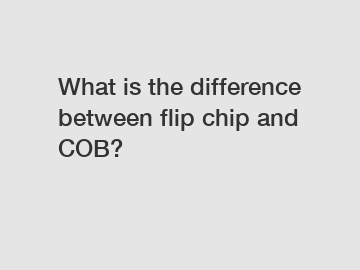What is the difference between flip chip and COB?
What is the Difference Between Flip Chip and COB?
When it comes to semiconductor packaging, two popular options are flip chip and chip on board (COB) technologies. Both methods have their advantages and are commonly used in various electronic devices. However, it is essential to understand the differences between them to select the most suitable option for specific applications. In this article, we will dive deeper into the disparities between flip chip and COB, exploring their features, benefits, and typical applications.
Flip Chip: A Technological Marvel.

Flip chip technology involves directly mounting the semiconductor die on the substrate or carrier. The major characteristic of flip chip packaging is the face-down placement of the chip, where it is "flipped" to make contact with the substrate. This technique utilizes solder bumps or balls as the interconnects between the die and the substrate, allowing for excellent electrical and thermal properties.
H2: Features and Benefits of Flip Chip.
Flip chip packaging offers several advantages over other packaging methods, making it suitable for a wide range of applications. Here are some key features and benefits of flip chip technology:
1. Miniaturization: Flip chip technology enables compact designs, as it eliminates the need for bond wires or lead frames. With direct electrical connections, the overall size of the package can be significantly reduced, making it ideal for smaller devices.
2. Enhanced Electrical Performance: The shorter connections in flip chip packaging result in reduced inductance and improved high-frequency performance. This characteristic makes it highly suitable for applications that require high-speed data processing or RF devices.
3. Effective Heat Dissipation: The flip chip configuration puts the die in direct contact with the substrate, allowing for efficient heat dissipation. This feature is crucial in devices that generate a significant amount of heat, such as power modules or processors.
4. High Pin Density: Flip chip technology enables a high pin count, making it ideal for applications that require multiple input/output (I/O) connections, such as microprocessors or memory modules.
Chip on Board (COB): A Reliable Assembly Technique.
Unlike flip chip packaging, COB involves mounting the bare semiconductor die directly onto the printed circuit board (PCB) or substrate. The die is bonded to the board using conductive adhesives or epoxy, and wire bonding is used to establish electrical connections between the die and the PCB.
H2: Features and Benefits of COB.
COB technology offers its unique advantages, making it an attractive choice for certain applications. Here are some key features and benefits of COB:
1. Cost-Effective: COB eliminates the need for separate packaging, such as lead frames or plastic moldings, resulting in overall cost savings. This makes COB an ideal choice for mass production applications where cost optimization is crucial.
2. High Flexibility: COB allows for greater design flexibility since the size and shape of the PCB can be tailored to the application's requirements. It is particularly advantageous in applications where space is limited or irregularly shaped.
3. Increased Reliability: The direct placement of the die on the PCB eliminates the use of wire bonds, which can be susceptible to mechanical stress or failure. This improves the overall reliability of the device.
4. Efficient Thermal Management: COB allows for effective heat dissipation as the die is in direct contact with the PCB. This feature is beneficial in applications that generate heat and require reliable thermal management.
Conclusion.
In summary, flip chip and COB are two distinct semiconductor packaging technologies, each with its advantages and specific use cases. Flip chip is known for its miniaturization capabilities, enhanced electrical performance, heat dissipation, and high pin density. On the other hand, COB offers cost-effectiveness, design flexibility, increased reliability, and efficient thermal management. Choosing between the two depends on factors such as the application requirements, production scale, and budget constraints.
For more information about flip chip and COB packaging technologies, feel free to contact us. .
Want more information on flip chip cob distributor, 100 watt cob led, high cri 95+ cob led? Feel free to contact us.
125
0
0


Comments
All Comments (0)